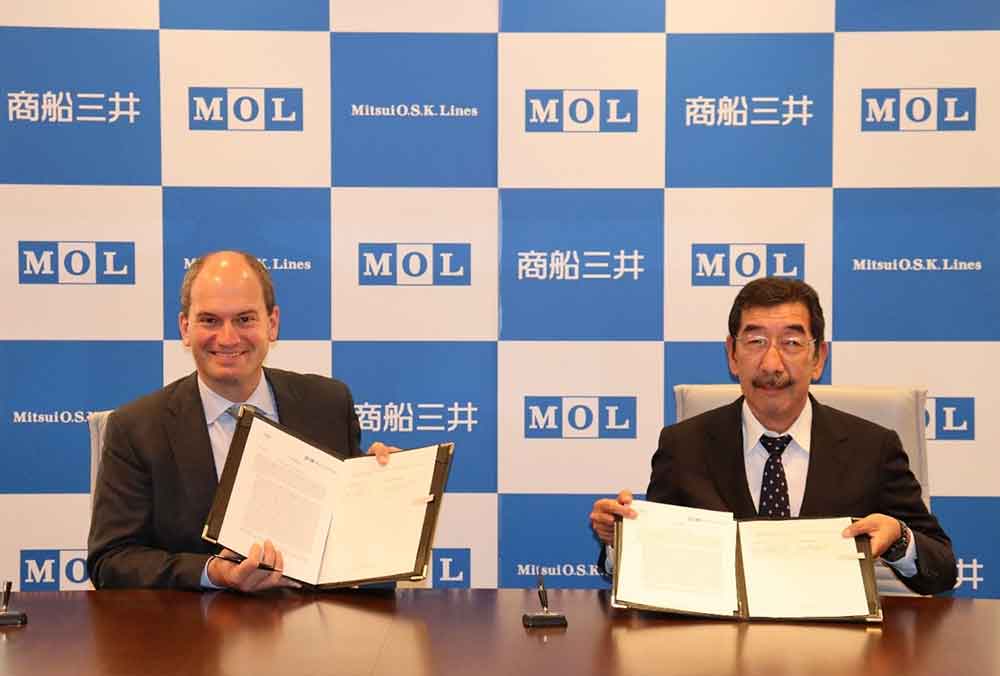Enviva, MOL Drybulk Debut New Partnership
Enviva and MOL Drybulk Ltd., a subsidiary of Mitsui O.S.K. Lines Ltd., a leading global marine transport group, announced they have signed an additional memorandum of understanding to deploy an environmentally friendly bulk carrier (“EFBC”) to reduce the greenhouse gas (“GHG”) emissions in the ocean transportation of sustainable wood pellets and biofuels. Following a successful joint study phase, the EFBC is scheduled for launch in 2024 and will aim to utilize rotor sail technology developed by Anemoi Marine Technologies Ltd together with MOL’s ‘Wind Challenger’ technology, which would both reduce emissions by harnessing wind energy, for an expected average GHG savings of about 20% in total. The 62,900-deadweight tons (dwt) vessel will be built by Oshima Shipbuilding.

Thomas Meth, Chief Commercial Officer of Enviva and Kazuhiko Kikuchi, President of MOL Drybulk at the signing ceremony.
As part of Enviva’s goal to achieve net-zero GHG emissions from its operations by 2030, the company has committed to addressing scope 3 emissions by proactively engaging with partners like MOLDB to develop and implement new clean energy solutions. As shipping pellets across the Atlantic Ocean currently comprises one third of Enviva’s supply chain emissions, this partnership will generate a large carbon savings in its upstream and downstream value chain.
“Reducing greenhouse gas emissions in our supply chain is a foremost priority for us,” says Thomas Meth, Chief Commercial Officer of Enviva. “While we have made progress in reducing our operations’ CO2 footprint, there are more innovative opportunities like the one we are partnering on with MOLDB to continue to strive for more circular approaches in our supply chain. We couldn’t be more excited about continuing to build on our relationship with MOLDB to help reach our goals of achieving net-zero greenhouse gas emissions by 2030.”
Kazuhiko Kikuchi, President and Representative Director of MOLDB adds, “We are very happy to make this announcement today alongside our long-term partner, Enviva. Their support and commitment to this project is invaluable. The purpose of launching MOLDB is to become a team of professionals in the dry bulk business, working closely with our customers to meet their needs and provide solutions. The EFBC is a great example, and we cannot wait to see this truly unique vessel set her sails and catch the wind.”
Plans to develop the Wind Challenger started in 2009 as an industry-academia joint research project led by the University of Tokyo. MOL took charge of the plan in 2018 and has been working on the technology since. The first Wind Challenger is scheduled to be released in the second half of this year. The system converts wind energy to propulsive force with a telescopic hard sail. The long-term goal is to develop a widely accepted shipping solution to achieve the International Maritime Organization target in combination with other measures to reduce GHG by equipping vessels with multiple sails.
RELATED ARTICLES:
UK Biomass Demand Rises; Enviva Reports New Japanese Contract
Enviva Considers Biomass Role In Hydrogen Economy
Finite Carbon Receives New Majority Stakeholder
Enviva, Finite Carbon Focus On Small Landowners
Enviva Reports On New Pellet Projects
Latest news
USA Bioenergy, LP Sign Feedstock Letter Of Intent
USA Bioenergy, LP Sign Feedstock Letter Of IntentUSA BioEnergy (USABE) has signed a letter of intent with LP Building Solutions (LP) outlining plans to enter a long-term supply agreement for sustainably sourced wood fiber to support operations at USAB’s planned Texas...
Michigan Company Opens AI Powered Biomass Facility In Grand Rapids
Michigan Company Opens AI Powered Biomass Facility In Grand RapidsWoodchuck, an AI-powered climate tech company focused on transforming wood waste into renewable energy, officially opened its flagship biomass processing facility in Grand Rapids, Mich. in early May....
Andritz Acquires LDX Solutions
Andritz Acquires LDX Solutions Andritz has acquired LDX Solutions, a provider of emission reduction technologies and related services in the North American industrial market, with annual revenues of about $100 million. This acquisition further strengthens Andritz’s...
Beaver Lake Renewables Begins Front-End Engineering Design
Beaver Lake Renewables Begins Front-End Engineering DesignOfficials with SunGas Renewables recently announced the start of front-end engineering design (FEED), marking the beginning of the final stage of development for its flagship project, Beaver Lake Renewable...
Find Us On Social
Subscribe to Our Newsletter
Wood Bioenergy News Online hits the inboxes of subscribers in the wood-to-energy sectors.
Subscribe/Renew
Wood Bioenergy is published and delivered worldwide 6 times per year. Free to qualified readers in the U.S. Subscribers outside the U.S. are asked to pay a small fee.
Advertise
Complete the online form so we can direct you to the appropriate Sales Representative.
